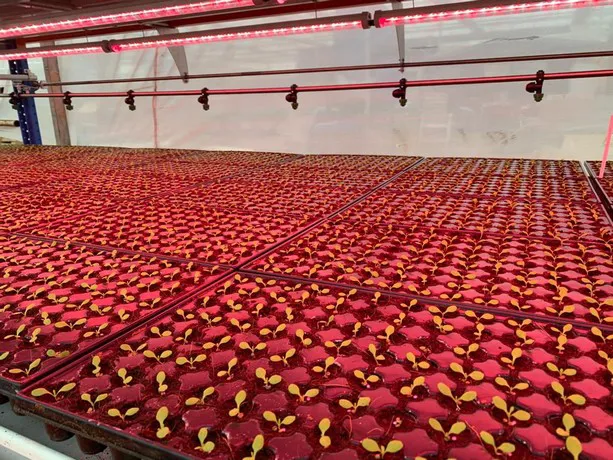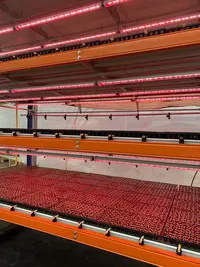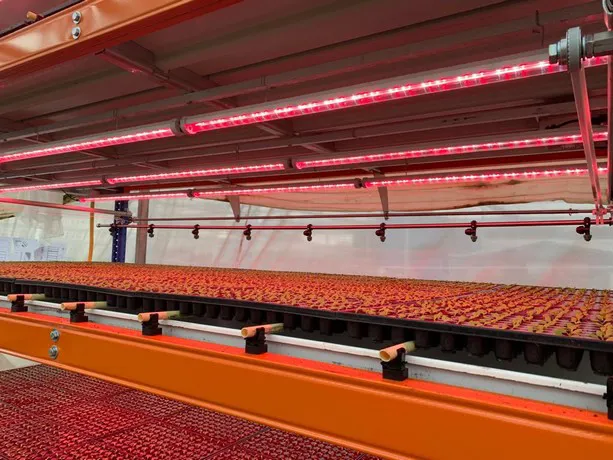'Where in recent years vertical farming enthusiasts have perhaps been mainly qualified as hipsters with a rather expensive hobby, this new branch of horticultural sport is steadily on the rise and traditional growers are also finding their way to the multi-layer installations.'
They see opportunities in using techniques from vertical cultivation, for example in propagation. “It is not just about improving the quality of the young plants, but above all about the controllability of the cultivation, and thus the speed and quality,” says Koen with Mechatronix.

What is the most expensive greenhouse there is? That would be an empty greenhouse, and that is exactly where, according to Koen van Mechatronix, opportunities lie for vertical farming. “In lettuce cultivation you see many nurseries working with fully automated cultivation systems. With mobile gutters they can use the available space in the greenhouse as efficiently as possible. However, it remains difficult to adjust the speed of the preliminary cultivation to the available space in the pond. By replacing traditional, unexposed or illuminated cultivation with a cultivation that is more controllable in a multi-layer system, you can plan much more precisely how many plants to set up. Accurate to the day, you know how many plants are ready to go in,” he says.
 The lighting company developed a multi-layer cultivation system together with Meteor Systems: an automated track, including spray booms. In the past quarter, intensive testing was already carried out with a grower who works with floating gutters. “We have 120,000 cuttings up in the test setup. Multi-layered, of course, because otherwise it would be too expensive in terms of floor space. Now you can grow enough cuttings on a few square meters to fill 1 / 3rd of the garden,” he shows.
The lighting company developed a multi-layer cultivation system together with Meteor Systems: an automated track, including spray booms. In the past quarter, intensive testing was already carried out with a grower who works with floating gutters. “We have 120,000 cuttings up in the test setup. Multi-layered, of course, because otherwise it would be too expensive in terms of floor space. Now you can grow enough cuttings on a few square meters to fill 1 / 3rd of the garden,” he shows.
The controlled cultivation makes it possible to use the entire cultivation system more intensively, which shortens the payback period and the depreciation period. “You can get more heads of lettuce from your expensive greenhouse,” Koen summarizes. “In addition, you always send exactly the same quality plants to the pond, which also gives you more control over your outgrowth. If you still adhere to the correct lighting strategy, you can start making a perfect prediction on your planning. This wasn't possible before. ”

Further opportunities
In herbs there are also opportunities for hybrid cultivation, where part of the cultivation will takes in an indoor or multi-layer cultivation system and the outgrowth will take place "as usual" in the greenhouse. “In the classic, fast-growing herbs, a full indoor cultivation is soon done, but in the woody herbs it is purely the rooting that takes place in a VF installation,” says Koen. “Total cultivation is too slow for this. Your turnaround time is too long and that makes the investment per m2 too expensive, but rooting often goes perfectly in a VF system.” In the same way, plant breeders use the techniques in part of the propagation, for example to improve healing after grafting, or to speed up cultivation from mother plants. "Ultimately, propagation is about the controllability of a known phase of the propagation."
All in all, this means that there appear to be more and more surprising opportunities for vertical farming, also in Europe. “The first major projects are starting to arrive, although we also see that people here are even less familiar with the possibilities and often depict it as expensive cultivation,” says Koen. “And of course an economic assessment must always be made. It will not be the case that complete crops will be placed indoors here tomorrow - there is always a reason to look at the sun. Where possible we use the sun, and where necessary the lighting. ”

For more information:
Koen Vangorp
MechaTronix
koen@mechatronix-asia.com
www.horti-growlight.com
